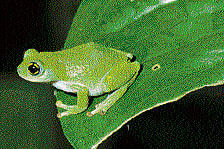
They came to this planet much before the majestic lions, tigers and elephants arrived.
In fact, they were among the first vertebrates to populate the world more than 300 million years ago. But while several global efforts are on to save charismatic large animals, the ubiquitous frogs are facing the threats of extinctions.
''Amphibians including frogs are the most threatened land animals though they are keystone species. Globally, there are 6,000 species of amphibians, out of which 2,000 are endangered,” said Don Church, director of Global Wildlife Conservation, an international conservation outfit.
Project for frog conservation
India could well become the first country to have a conservation programme for amphibians including frogs. With the ‘Lost Amphibians of India’ initiative slated to close in a couple of months, researchers are now putting together a large-scale project on the need to conserve Indian frogs, which would be submitted to the government for approval.
Spearheaded by a team of field biologists from Delhi University, the unique initiative was launched last year to find out whether 52 amphibian species had vanished from India. Many of these species are seen only inside spirit jars or known to researchers through sketchy descriptions in text books.
The list of the most wanted species include frogs and tiny snake-like caecilians. The oldest in the list is a frog, seen last in undivided Bengal in 1834, while the youngest is a caecilian that was spotted till 1992 in Kerala’s Chegalam village. As many as eight frog species were last seen in Karnataka.
After a year of search in 17 states involving 280 members from 20 teams, the frog-hunters identified almost 70 per cent of the species. “The oldest one is a species last seen in 1874. The hunt is still on and we will take another two complete the project,” SD Biju, a Delhi University field biologist said at a workshop on amphibians in Thiruvananthapura last week.
Out of the 52 lost amphibians, nine species were last seen between 100-177 years whereas 26 animals were spotted between 50-100 year ago. Other 17 lost species are relatively new as they were last spotted within the previous 50 years. The frog species are now being rediscovered in Darjeeling, Hasan and Silent Valley in Kerala among others locations.
Five species in Karnataka
Within three months of launching the operation, five species were found including one from Karnataka. It is an elegant tropical frog (Micrixalus elegans), known to scientists from an original description based on a collection in 1937. The original specimen was lost till it was rediscovered by field biologists in a forest stream-bed in Kempholey in Hassan district.
The most vintage of the five was a green species that was last seen in 1874. Rediscovered from Kodayar in Tamil Nadu after 136 years, the striking fluorescent green frog with ash-blue thighs and black pupils with golden patches leads a secretive life, presumably inside reeds during the day.
India currently has 317 known species of amphibians – 283 frogs (order Anura), 33 caecilians (Gymnophiona) and 1 salamander (Caudata). Out of these 300 odd species, 168 are found in the Western Ghats with 146 endemic species, which means these animals are not found anywhere in the country except the Western Ghats. Kerala too has
40 endemic species though 100 frogs and 12 caecilians are found in the Kerala forests.
“Since 2000, more than 90 frogs have been discovered, 28 per cent of which are Indian species,” said KV Gururaja, a frog researcher at Indian Institute of Science, Bangalore. A search by the IISc team in four protected forests of Karnataka – Dandeli-Anshi, Kudremukh, Sharavathi and Bhadra – revealed presence of 25 species, 16 of which are endemic. “It shows the importance of conservation even outside the protected ares,” he said.
Rampant habitat loss, forest fires, road kills, pesticide use, commercial interests, introduction of alien species and diseases are pushing the hapless frogs to extinctions. While Indian forest officials are conservationists are familiar with the first six causes, its the seventh factor that may spell trouble for the frogs, big time.
Gururaj and his colleagues spotted fungal infections in frogs in Dandeli. This is the first case of finding out fungal infections in frog species – which could be potentially devastating – in India. But since the team could not identify the infection on the frog skin due to a contaminated sample, the scientists are not sure if it was a case of deadly Chytrid infections.
According to the OIE (World Organisation for Animal Health) both Chytridiomycosis and ranaviral diseases are notifiable diseases, which can bring disaster among the frogs. Habitat loss too is another big worry. “Habitat change in the next 10-20 years will take place in the same area where amphibian species diversity exists. For instance 95 per cent of rain forest is lost in Sri Lanka. This means many of the 100 known Sri Lankan frog species are probably extinct,” said Church, who represents the International Union for the Conservation of Nature.
“Globally almost one third of known amphibian species are facing extinction. Among the vertebrates, they are the most threatened. But we need to preserve them as they are indicators of the environment,” Biju said.